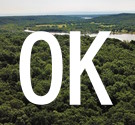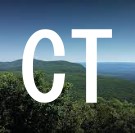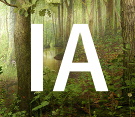|
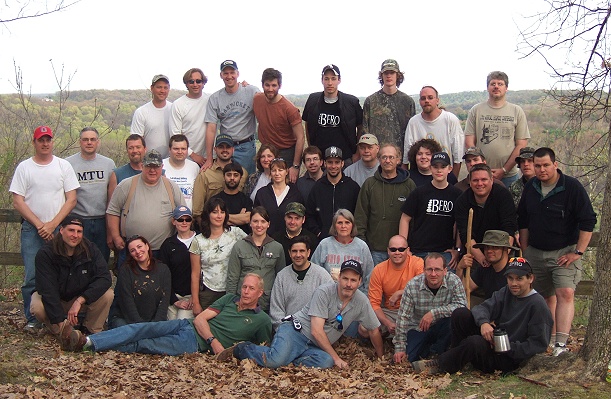
Reminder to those who attended the April 2006 Ohio Expedition:
Please email the photos requested to Mark Maisel in Cleveland.
His email address is [email protected]
The expedition took place in Columbiana County. The county has
a history of sightings. The reported sightings date back to
the 1970's. Much of the information is hearsay and thus not
shown on the public BFRO database. The relevant information
consistently points to some high-walled creeks bordered by a
substantial amount of forest land.
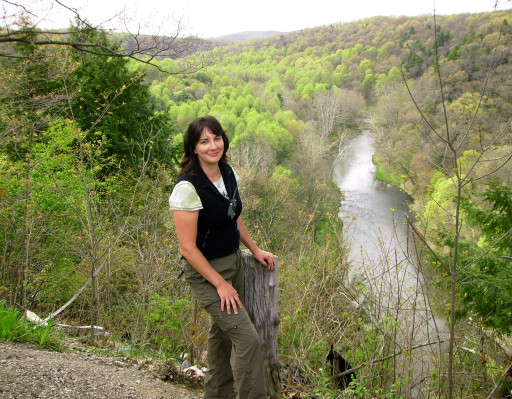 |
|
Springtime in Columbiana County, Ohio.
Florida BFRO investigator Caroline Curtis looks for good
acoustic vantage points above an important creek valley.
|
45 attended the expedition (not all of them are
pictured above). They came from twelve different US states and
one Canadian province.
There were several observations / incidents that be deemed Class
B or at least borderline Class B. The notes below mention only
a portion of those observations.
Two M.D. psychiatrists from a major Cleveland hospital described
being approached and stalked in a thick pine grove, five miles
or so upstream base camp. They also described something during
that incident which sounds very much like an infasound experience
-- some deep growls that got lower in pitch until they were
not audible, and then their hair stood up and they suddenly
had an inexplicable feeling of panic. This occurred more than
once over the course of a minute or so. Sub-audible "infrasound"
is an ability that certain large animals have, such as elephants
and large aligators.
On the previous night, a rock throwing incident
occurred along a creek closer to base camp. A team of nine people
had walked along a river trail late a night. They got to a point
along the creek and sat and rested for a while. They were not
trying to be furtive or conceal themselves during this night
hike. They wore small LED headlamps. Some of them even smoked
aromatic cigars when they stopped to rest, trying to make their
presence known in ways that would not be out of the ordinary
for this area.
After resting for about 15-20 mintues they decided to head back
to camp. They had only gone about 30 feet or so before a large
rock (size between a grapefruit and a volleyball) splashed into
the water behind the last three guys who were leaving. One of
those guys was a member of Canadian SWAT team. He was both adamant
and shocked to realize that the large rock must have come from
a grove trees on the opposited side of the creek -- approximately
100 feet away. Everyone kept their cool and kept walking to
see what would happen next. Nothing else happened along the
creek.
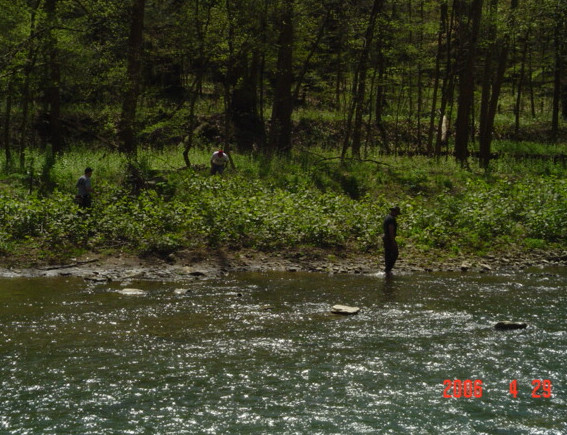 |
|
Looking for clues the day after a rock
throwing incident. This photo was taken from the side
of the creek where the large rock hit the water. The people
who were present when the incident happened said the rock
may have been as large as a volleyball, based on the splash
it made near them. One of the observers was a member of
a Canadian SWAT team. He was certain the rock came from
across the creek.
Some of the observers had nightvision
goggles and immediately looked in every direction after
the rock hit the water, including this area across the
creek, but saw nothing. The only signficant brush breakage
was behind the ruins of an old wall, seen in the background
behind the trees, at least 100 feet away from where the
large rock landed.
|
Within a half hour of the group's return to base camp, some
heavy "home run" wood knocks were heard deep in the
woods on the hillside below the base camp. The knocks were "call
and answer" style, coming from different directions a few
hundred yards from the base camp area.
Several people offered to go into the area where the sounds
were coming from and move toward the sounds. Two people with
3rd generation night vision goggles quickly went down the trail
directly toward the sounds. They heard more knocking as they
progressed down the trail, and briefly observed "eyeshine"
at approx. 60 feet away through brush. Two other small groups
went to the trail exits on both sides of that small valley to
see if there was any indication of people, etc., in the woods
nearby. There were no people and no vehicles seen from the bottom
end of the valley. The knocking sounds continued even after
the trail exits were "sealed" by the groups that volunteered
to go for a look.
Walking off this trail is difficult even in daylight. The two
people with the nightvision goggles who got closest to one of
the noise-makers said they could not walk right up to where
the "eyes" were seen, not without physical risk due
to loose rocky surfaces. They felt that whatever it was, was
probably not human, because the area was too dark to navigate
without some kind of flashlight or nightvision devices with
IR illuminators.
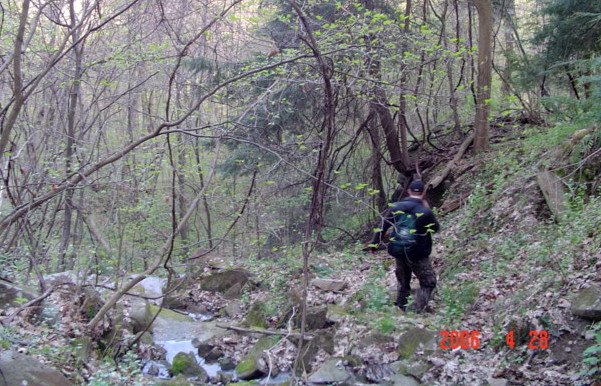 |
|
In the area where the knocks and eyeshine
were observed the night before. The leaf litter and rocky
surface prevented any clear track impression off the trail.
|
The 3rd generation nightvision goggles used by
the two guys approaching the sounds required their infrared
LED illuminators to be turned on in order to see the ground.
The animal that was apparently making the loud wood knocks was
able to move off quietly through this terrain without the aid
of any visible or IR illumination. The 3rd gen devices worn
by the pursuers have seen any kind of illumination, even infrared
illumination.
We spoke with some local people about sounds, sightings, etc.,
in the area, and found out that a well known ghost legend includes
a related element -- the "ghost" that haunts the creek is said
to throw rocks at fishermen at night. The area was inspected
the next day. One possible 18" track was found and photographed.
Not far from the area where the rock throwing occurred, a small
pile of fresh water clam shells was found the next day. That
portion of the creek has a muddy bottom and there are fresh
water clams just under the surface of the mud. This incident,
and some reports from other states, potentially suggests that
these animals will occassionally try to deter humans from walking
along certain creeks and small rivers at night, for some reason.
It is possible that they may be foraging in those
streams after dark. Fresh water clams and muscles in shallow
creeks would be the easiest animal protein sources to obtain.
They are the only animal protein sources that are both abundant
and do not run away. Crawdads would also be plentiful sources
of protein these same creeks in Spring and Summer. This is not
to suggest that they only pursue, or even primarily pursue,
these sources of animal protein, but rather that clams, muscles
and crawdads may be part of their diet. Clams, muscles and crawdads
are certainly available in many creeks in the Midwest and elsewhere.
_______________________________________________________________________
Mateja's Ohio Expedition Journal Below
There were many groups deployed at various locations over the
three nights. The notes are only for the groups I was in. It
is by no means complete nor 100% accurate. I encourage all expedition
members to contribute. Please feel free to correct and add to
the journal. Enclose any corrections in brackets below the original
text and please identify yourself. I will then edit and incorporate
the corrections into the journal. I apologize to all where I
have forgotten a name or event. I recorded the events the following
day after little sleep; no doubt there are many gaps. I hope
when we are done we will have as close to a complete record
as we can get.
Thursday, April 27, 2006
A group of approximately 20-25 people were deployed along [a
creek trail] about four miles to the north of base camp. This
group was split into five smaller groups of 4-5 people each
and then spread along the [creek trail]. The small groups were
separated from one another at a distance of 100 yards or so.
The groups all walked the trail in the dark at least 1.5 miles.
Two members of group #4 heard rustling on a couple of occasions
at the creek bed below us. It was not exceptionally loud and
was not suggestive of bipedal walking. The sound was suggestive
of a medium size animal perhaps a deer or bear. At one point
a low moan was heard by two members of group #4.
In an attempt to elicit a vocal response in the area, two techniques
were used: wood knocking and vocalizations in specific patterns
suggested by the BFRO guides. At several points along the route
wood knocking was attempted. At approximately 1:00 a.m (Friday,
April 28, 2006) a return wood knock was heard in response. During
the night along this trail some vocalization imitations were
made by Prof. Chris Noel and another member of the group. At
approximately 1:30 a.m. (Friday, April 28, 2006) after one of
these vocalization imitations, a return response was heard.
The returned vocalization sounded very similar to Noel's call.
Immediately thereafter, coyotes started to yelp from a slightly
different direction. One of the guides later noted the parallel
to the sequence of events the night before the Skookum Cast
was obtained in 2000, involving coyotes heard in the same vicinity
as the louder, non-coyote screamer which eventually left the
partial body imprint.
Three members of the group on the trail - Chris Noel, Mark Maisel,
and Paul Mateja felt strongly that the vocalization was not
a coyote and could very well be a sasquatch, factoring in the
terrain equation and all the other information from the vicintiy.
It is my opinion (Mateja) that the coyotes started to yelp in
response to the alleged initial, possible sasquatch vocalization,
not to Noel's simulation.
A final vocalization was attempted approximately
15-20 minutes later. No response was heard. The group returned
to base camp shortly thereafter.
Friday, April 28, 2006
A group of approximately 15 people were deployed
along the same trail. A BFRO guide, and Prof. Chris Noel, and
Mike Greene (retired state official from NJ) deployed along
the ridge above the trail, which ran along a large creek. The
group walked in approximately 1.5 ? 2.0 miles. A vocalization
by the BFRO guide elicited a return response. Those who were
along the trail bed could not hear the sound clearly. Those
on the ridge heard it more clearly and all of three of them
(who have each attended at least five expeditions) felt certain
that it was a sasquatch vocal response and not a coyote. More
sound stimulis were attempted but no responses were heard. The
group returned to base camp at 2:30 a.m. (Saturday, April 29,
2006)
Saturday, April 29, 2006
A small group: Green, Noel, Steuber, Willis, and Mateja went
to a private home to interview a witness about occurrences on
the property. Four or five incidents have occurred over a span
of three months. The intruder has rummaged through garbage and
banged on the side of the house. The property owner has heard
heavy foot steps on the gravel driveway. What makes this case
interesting is the manner by which the garbage can is disturbed.
The garbage can has a hinged top. The interloper opens the lid,
rips open the bags, extracts the food it is interested in, and
then closes the lid. No unusual activity was observed by the
group during the visit. The group returned to base camp at 1:45
a.m.
About Rock Throwing
Rock throwing has been noted by multiple observers during
BFRO expeditions in sighting areas in the following states:
New Mexico (Jicarilla Apache Res.)
Northern California (Redwoods)
Oklahoma (Ouchita Mountains)
West Virginia (Pocahontas County)
Ohio (Columbiana County)
When people were actually hit by rocks, they were relatively
small (golf ball) size rocks. Whereas, when rocks were thrown
into streams nearby, apparently to make a loud splash sound,
they seemed to be much larger rocks. The incidents involving
the larger rocks bring to mind this old newspaper article
from the 1930's.
Click on the article to see the larger version.
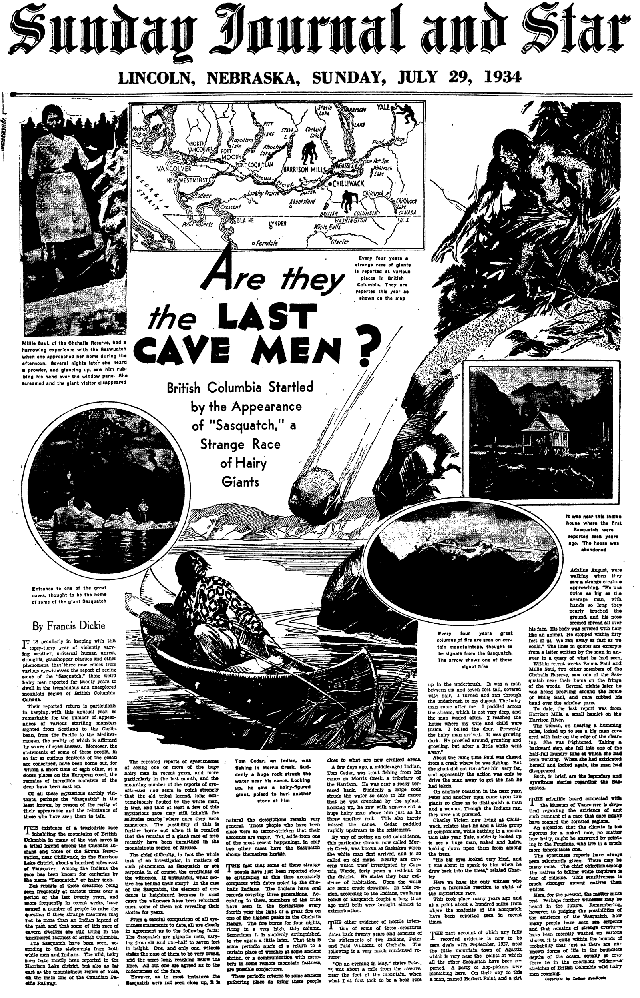
|






